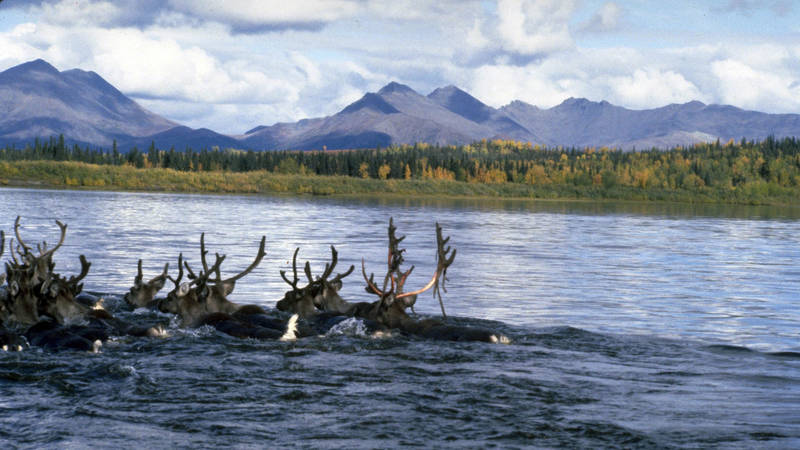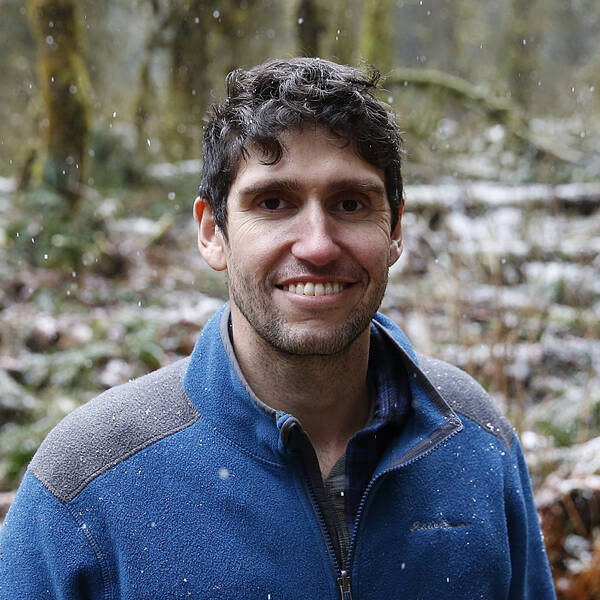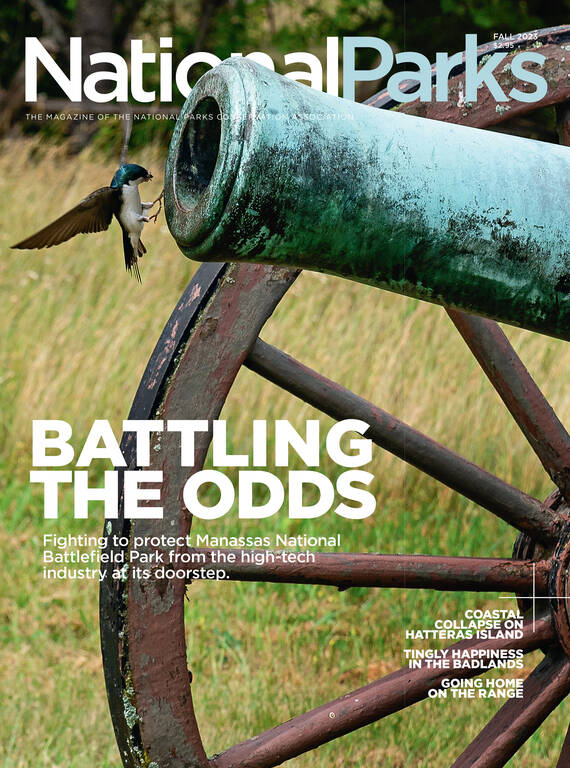Fall 2023
Killer on the Road
Cars helped make national parks America’s most beloved landscapes — and wreaked havoc on wildlife. What will it take to repair the damage?
The elk sprawled on the shoulder of Highway 20, a slender thread of blood unspooling slowly from one nostril. We found her on a warm evening near Yellowstone Lake in the summer of 2009, my lone season working for the National Park Service. She’d been hit by a car, one of thousands that cruised through Yellowstone National Park that day, and her shattered legs — those slim, powerful appendages on which she’d forded rivers, evaded wolves, migrated with her herd — bent at angles that made me nauseous. She tried to lift her head, then lowered it with a moan. I’d been returning from a job site with colleagues when we came across the elk, and now I climbed back into our truck to escape the awful scene. Briefly, I lifted my eyes to the rearview mirror and saw a ranger lift his rifle. It seemed a small mercy that he only needed one shot.
Death on the road is a commonplace tragedy in and around national parks. By definition, parks are protected areas where animals are, in most cases, safe from hunting, development, fossil-fuel extraction and other pressures. Yet they’re also tourist paradises that host hundreds of millions of visitors each year, the large majority of whom arrive by car — a mode of transportation that snuffs out nonhuman life wherever it rolls. In a 2010 paper, researchers estimated that vehicles kill an astonishing 29,000 critters every year in Saguaro National Park alone, most of them reptiles and amphibians. Highway 89, the gateway to Grand Teton, is notoriously lined with deer, elk, moose and grizzly carcasses. The irony is thick: We visit parks to celebrate nature but may inadvertently participate in its destruction along the way.

Over/Under
On the outskirts of Glacier National Park, dozens of new wildlife crossings allow animals to traverse areas that once posed serious risks to human and critter alike. And it’s just…
See more ›In a sense, the road conundrum embodies the tension that has tugged at the Park Service’s heart since its founding in 1916. The agency was famously tasked with simultaneously conserving “wild life” and “provid(ing) for the enjoyment” of visitors. Stephen Mather, its first director, made his personal priorities clear: Building roads through parks, he declared, would “enable the motorists to have the greater use of these playgrounds.” Mather pushed for the construction of more than a thousand miles of park roads, among them iconic thoroughfares such as Glacier’s Going-to-the-Sun Road. Parks became what the historian David Louter called “windshield wildernesses” — landscapes whose spectacular scenery could be experienced from behind the wheel.
As traffic swelled, however, the autocentric model exacted a toll on the very animals national parks were established to protect. Visitors killed endangered Florida panthers in the Everglades, desert tortoises in Joshua Tree and bison in Yellowstone. In Yosemite alone, cars hit 300 black bears between 1995 and 2012. Such incidents endanger humans, too: Animal collisions kill around 200 drivers per year nationally, and car crashes are the second-leading cause of death in national parks.
Cars and roads are harming wildlife populations in myriad other ways, scientists have found. Denali’s fabled park road disrupts the seasonal movements of Dall sheep; the grumble of motorcycles along Going-to-the-Sun disturbs migrating songbirds. In a 2019 study, scientists found that anthropogenic noise pollution was evident in more than a third of recordings from 66 park sites, and that planes and cars are the worst offenders.

Smokies Wildlife Will Soon Have Options for Safe Passage in the Pigeon River Gorge
We can keep ourselves and wildlife safe — if we’re willing to prioritize these types of solutions for our roadways.
See more ›The Park Service has been working toward solutions, but a comprehensive fix remains elusive. While many parks have reduced speed limits and expanded signage warning drivers to watch out for wildlife, those measures haven’t solved the problem. As one conservationist put it in 2013, park roadkill risks becoming a “conservation failure.”
National parks aren’t alone in being plagued by roads. I’ve spent the past decade researching the environmental toll of our national transportation infrastructure for my book “Crossings: How Road Ecology Is Shaping the Future of Our Planet,” and I’ve learned that it’s virtually impossible to account for all the ways roads can distort nature. An estimated 1 million animals are crushed by cars every day in the U.S alone; highways genetically fragment populations of grizzly bears and mountain lions; and de-icing salt turns freshwater ecosystems salty. Even the microscopic particles shed by our tires cause damage by poisoning salmon.
These crises can feel utterly intractable: The 4-million-mile road network in the U.S. isn’t likely to contract anytime soon, and nearly all of us drive. In the course of my reporting, however, I also found that solutions exist, some of which the Park Service — which, unlike the Federal Highway Administration or state transportation departments, has wildlife conservation written into its enabling legislation — and its allies are perfectly suited to implement (and in some cases have already set in motion).
For one thing, we need to build more wildlife crossings: bridges and underpasses, flanked by roadside fences, that permit animals to safely traverse highways. One ideal candidate for crossings is Pigeon River Gorge, where I-40 runs past Great Smoky Mountains National Park. As traffic has increased within the gorge, collisions with black bears have spiked, and critters from coyotes to salamanders have been denied access to habitat. A coalition of nonprofits, including NPCA, has conducted research that will help agencies figure out where to build new crossings and retrofit existing culverts to permit animals to sidle under the interstate. And North Carolina’s legislature has expressed interest in setting aside money for passages, proof that the political appetite for wildlife crossings is catching up with the ample science that supports them.
In addition to averting dangerous crashes, the Pigeon River Gorge crossings may someday allow animals to seek new habitats as the Southeast warms. And connecting parks with broader landscapes is fast becoming a national movement: The same spirit animates the Wallis Annenberg Wildlife Crossing, a 210-foot-long bridge that will span Los Angeles’ massive U.S. 101 freeway. The roughly $90 million overpass, slated for completion in 2025, will allow inbred cougars in the Santa Monica Mountains National Recreation Area to mingle and mate with cats from other corners of Southern California. On an ever-warmer and more densely trafficked planet, safeguarding wildlife in parks inescapably requires confronting the highways beyond their borders.

Victory for 20 Million Acres of National Park Lands
The Biden administration protected America’s largest national park landscape by stopping a 211-mile industrial mining road that would have sliced through Gates of the Arctic National Preserve, disrupted caribou migration…
See more ›Of course, we also need to protect animals from cars within park boundaries. In 2021, the Park Service and its partners released the Roadkill Observation and Data System, a smartphone app that allows citizen scientists to report carcass sightings. The app isn’t just designed to occupy your kids as you road-trip around Bryce Canyon and Zion; it’s a scientific tool that will, in theory, help park managers pinpoint collision hotspots that might benefit from wildlife passages. We park visitors cause roadkill and are thus morally obliged to assist in its prevention.
Once, the idea of tackling the ecological impacts of roads in national parks would have been implausible for one simple reason: It can be expensive. (For example, a typical underpass can cost upward of a half-million dollars; an overpass usually runs $6 million or more.) But funding isn’t the obstacle it used to be. The 2021 Infrastructure Investment and Jobs Act created a pilot $350 million grant program to support efforts by states, Native Tribes and agencies such as the Park Service to identify collision hotspots and reduce incidents. And then there’s the 2020 Great American Outdoors Act, which allotted more than $6 billion to repair crumbling roads and other park infrastructure. If the Park Service is planning to reconstruct a decrepit highway, why not include an underpass for elk or upgrade a culvert for cutthroat trout in the process? “As those dollars are being invested, there’s a huge opportunity to look at connectivity,” said Bart Melton, director of NPCA’s wildlife program.
In my view, the Park Service would also be wise to reduce the number of cars that travel its roads. To be sure, many parks are already blessed with public transportation options: Places such as Denali and Zion boast longstanding, extensive bus systems, and Rocky Mountain, Grand Canyon and Glacier are among the parks with shuttles to beloved trailheads. But virtually no park boasts a bus system that covers its entire road network, and all too many vast parks, including places such as Yellowstone and Olympic, have virtually no public mass transit. We’re largely stuck with windshield wildernesses; one of the best things we can do for wildlife now in many places is to reduce the number of windshields.

National Parks
You can read this and other stories about history, nature, culture, art, conservation, travel, science and more in National Parks magazine. Your tax-deductible membership donation of $25 or more entitles…
See more ›The Park Service and its supporters also need to do everything they can to prevent the construction of new roads that threaten the integrity of park ecosystems. Take Ambler Road, a proposed 211-mile track that the state of Alaska wants to build to transport copper ore from open-pit mines — plowing across 26 miles of Gates of the Arctic National Park and Preserve along the way. Conservationists fear that the road, and the gargantuan mining trucks that may someday rumble along it, will disrupt the migrations of the Western Arctic’s caribou, a notoriously skittish species whose herds are already in precipitous decline. In the past, we built roads through parklands without comprehending the damage we’d inflict upon our wildest places; today ignorance is no longer an excuse for heedless construction.
More than a century after the Park Service’s creation, road management remains among its most vexing contradictions. This wouldn’t have surprised Stephen Mather, who, for all his automotive boosterism, also understood the damage that vehicles could inflict: A highway through southern Yellowstone’s Thorofare region, he once cautioned, “would mean the extinction of the moose.” The road was never built, and today the Thorofare remains the farthest you can get from a road in the contiguous U.S., around 20 miles — a reminder that parks, for all their asphalt, can still provide sanctuaries on our paved planet.
About the author
-
 Ben Goldfarb Author
Ben Goldfarb AuthorBen Goldfarb is the author of "Crossings: How Road Ecology is Shaping the Future of Our Planet" and “Eager: The Surprising, Secret Life of Beavers and Why They Matter.”


